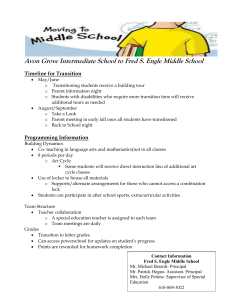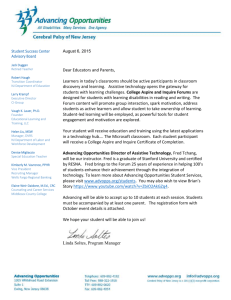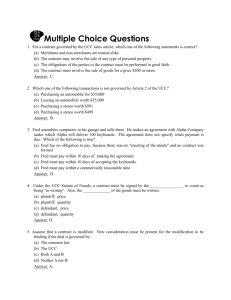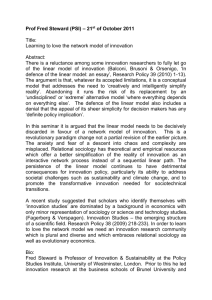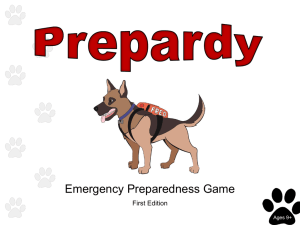My lesson plans draft
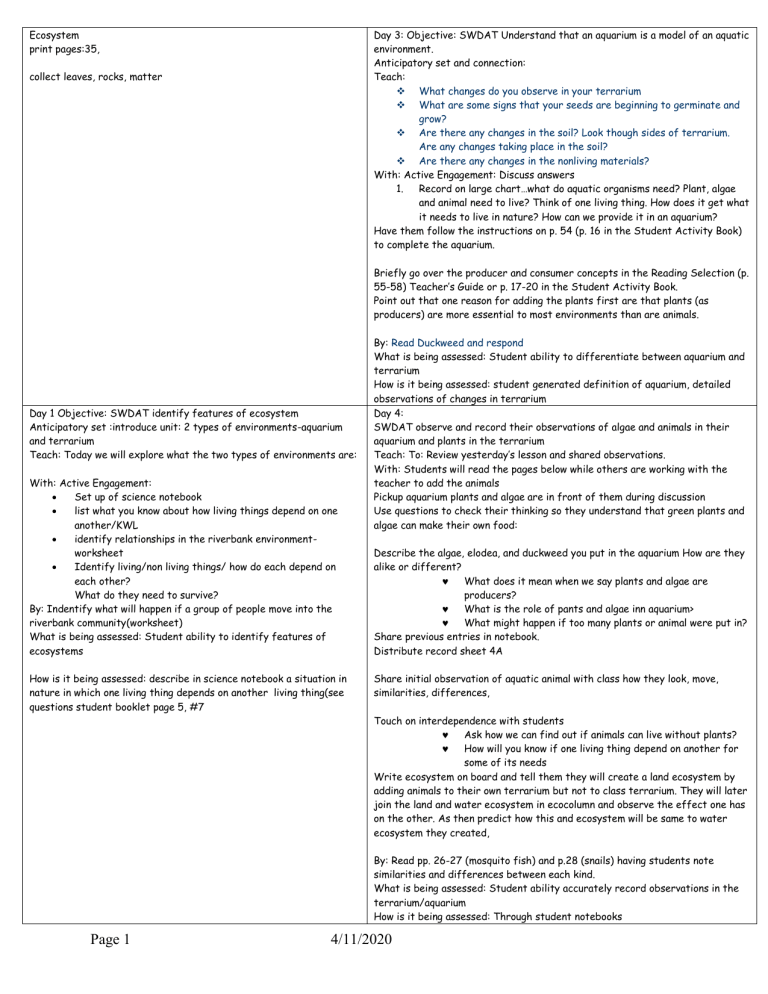
Ecosystem print pages:35, collect leaves, rocks, matter
Day 1 Objective: SWDAT identify features of ecosystem
Anticipatory set :introduce unit: 2 types of environments-aquarium and terrarium
Teach: Today we will explore what the two types of environments are:
With: Active Engagement:
Set up of science notebook
list what you know about how living things depend on one another/KWL
identify relationships in the riverbank environmentworksheet
Identify living/non living things/ how do each depend on each other?
What do they need to survive?
By: Indentify what will happen if a group of people move into the riverbank community(worksheet)
What is being assessed: Student ability to identify features of ecosystems
How is it being assessed: describe in science notebook a situation in nature in which one living thing depends on another living thing(see questions student booklet page 5, #7
Page 1
Day 3: Objective: SWDAT Understand that an aquarium is a model of an aquatic environment.
Anticipatory set and connection:
Teach:
What changes do you observe in your terrarium
What are some signs that your seeds are beginning to germinate and grow?
Are there any changes in the soil? Look though sides of terrarium.
Are any changes taking place in the soil?
Are there any changes in the nonliving materials?
With: Active Engagement: Discuss answers
1.
Record on large chart…what do aquatic organisms need? Plant, algae and animal need to live? Think of one living thing. How does it get what it needs to live in nature? How can we provide it in an aquarium?
Have them follow the instructions on p. 54 (p. 16 in the Student Activity Book) to complete the aquarium.
Briefly go over the producer and consumer concepts in the Reading Selection (p.
55-58) Teacher’s Guide or p. 17-20 in the Student Activity Book.
Point out that one reason for adding the plants first are that plants (as producers) are more essential to most environments than are animals.
By: Read Duckweed and respond
What is being assessed: Student ability to differentiate between aquarium and terrarium
How is it being assessed: student generated definition of aquarium, detailed observations of changes in terrarium
Day 4:
SWDAT observe and record their observations of algae and animals in their aquarium and plants in the terrarium
Teach: To: Review yesterday’s lesson and shared observations.
With: Students will read the pages below while others are working with the teacher to add the animals
Pickup aquarium plants and algae are in front of them during discussion
Use questions to check their thinking so they understand that green plants and algae can make their own food:
Describe the algae, elodea, and duckweed you put in the aquarium How are they alike or different?
What does it mean when we say plants and algae are producers?
What is the role of pants and algae inn aquarium>
What might happen if too many plants or animal were put in?
Share previous entries in notebook.
Distribute record sheet 4A
Share initial observation of aquatic animal with class how they look, move, similarities, differences,
Touch on interdependence with students
Ask how we can find out if animals can live without plants?
How will you know if one living thing depend on another for some of its needs
Write ecosystem on board and tell them they will create a land ecosystem by adding animals to their own terrarium but not to class terrarium. They will later join the land and water ecosystem in ecocolumn and observe the effect one has on the other. As then predict how this and ecosystem will be same to water ecosystem they created,
By: Read pp. 26-27 (mosquito fish) and p.28 (snails) having students note similarities and differences between each kind.
What is being assessed: Student ability accurately record observations in the terrarium/aquarium
How is it being assessed: Through student notebooks
4/11/2020
Page 2
Day 2 Objective: SWDAT Understand that a terrarium is a model of a terrestrial environment
Anticipatory set: get students excited about setting up terrarium; identify what terrarium/terrarium means using vocabulary and what will be included
Teach
To: Today we will be setting up our terrarium. What other times have you heard the word “terra”
With :
Collect rocks, twigs, leaf matter
Discuss importance of setting up planting correctly (too many seeds will cause overcrowding)
Review directions in student book 11/12
Model how to make the terrarium
By students will work in small groups to set up the terrariums
Discuss importance of close observation of materials in terrarium-use hand lens
Cleanup
What is being assessed: student ability to understand what a terrarium is
How is it being assessed: student record sheets and predictions written in notebook-which seeds will germinate first, look like, materials change, what about the role of the plants clarity completeness, accuracy and vocabulary of student work sheets;
Lesson 5: Observing the Completed Aquarium
How do the living and nonliving things in the aquarium affect each other?
Day 5 Objective: SWDAT Predict what changes might occur in both their aquaria and terrarium.
Anticipatory set: Offer evidence of the dependent and interdependent relationships they have observed in their own ecosystems
Teach: To: Either lead a group discussion on the components of the aquarium
(see under Background. 77 for ideas)
With: complete a webbing activity with them (see p. 79). If pushed for time, omit this lesson
By: Active Engagement: Students will pick up aquaria and hand lenses to refer to
1.
Give time to make informal observations on their own
2.
Share
3.
Explain that to help them understand the relationship in the aquaria, they will record them on a web
4.
Put aquarium in middle and living/nonliving to side
5.
Expand until a relationship web is made so they know they are interdependent on each other
6.
Continue to record and observe, Observing the Complete Aquarium pp. 79-82
7.
Student Activity Book: Lesson 5pp. 29-31
Differentiation: grouped by ability
What is being assessed: Student’s predicating based on observation
How is it being assessment: Journal entry shows documentation of evidence of the dependent and interdependent relationships
4/11/2020
Objective
Teach:
Lesson 6: Adding Animals to the Terrarium
SWDAT Identify and record similarities and differences between crickets and isopods.
To: Note on handling the crickets: Because they are such active animals, the Ecosystems
Remove the empty container from the bag. Shake the crickets from the paper and remove it. You now have the crickets confined within the bag, and it is easy to capture a cricket in your hand, remove it, and add it to a plastic cup or terrarium.
1. Since there is not enough time for the seeds to germinate and grow, add a bit of lettuce to each terrarium to provide food.
With: Briefly go over the information about isopods and crickets in the Reading Selections on. 92-93 (p. 38-40 in the Student Activity
Book).
3. Refer participants to the instructions for adding isopods and crickets to the terrarium on. 90-91 (p. 36-37 in the Student Activity
Book).
Pick up terrarium and hand lenses and observe
Record observations with team mates and review notes in science journal
Share observations and what they learned
Discussion questions
How long did it take for seeds to germinate? How many germinated?
Can you observe any roots? Compare them.
What happened to the seed coats on the seeds?
What is the job of the seed coat?
Why did we wait until now to add animals?
By: Create Venn diagram to compare aquarium plans and terrarium plants in journal’
Distribute record sheet 6A adding crickets and provide lesson on how to add them (unless teacher already did.
Final discussion:
How are your two crickets alike or different?
How re the crickets and isopods alike and different?
What body parts did you observe?
What did the animals do?
Compare water and land ecosystem and ask if the definition of ecosystem has changed?
What is being assessed: student ability to identify differences between crickets and isopods
How is it being assessed: Journal entries
Lesson 9
SWDAT identify effects of pollution
Anticipatory set: review definition of pollution
Teach:
To: Read Come Back Salmon
With: Talk about and introduce cause/effect
The teacher should briefly review cause/effect. After the students have come into the room and sit down, the teacher should turn off the lights.
Ask, "What's wrong?" (It is dark or the lights went off.) When students answer, ask, "Why?" (The teacher turned the lights off.) Explain that the first event happened because of the second event. What is the cause?
(teacher turned lights off) What is the effect? (it is dark) Explain that most of the time, it is easy to understand that one thing leads to another, that one event causes something else to happen.
Now give students this scenario: I got home last night and the first thing
I did when I opened my back door was to flip on the light switch. No lights came on! I looked across the street and there was a light shining in my neighbor's window. Ask students: Do we know the exact cause of my lack of lights? (No.) Do we know the effect? (Yes, you had not lights.) Can we guess what the cause is? (Yes. - accept any reasonable answer - there will be many - limb on line, blown light bulb, on a different line that neighbor, etc.)
Ask - What if I said, "Everyone around me had lights" or "Nothing electrical worked in my house" or "I wonder if I forgot to pay my bill."
Accept reasonable answers, and say to students that sometimes we have to guess what a cause or effect is because it is not always stated in what we are reading.
Read chapters 1 and 2 of Come Back, Salmon by Molly Cone aloud with the students. Discuss the chapters by using some or all of the following questions:
What does "adopting" a stream mean and why did the school decide to adopt Pigeon Creek?
What is a watershed?
How does pollution in the creek show that the area around the creek must be clean in order to keep the stream water clean?
After reviewing the parts of a good paragraph, have each child complete the following task. If a polluted area was located near your school or home, would you be willing to take part in its cleanup? Write a good paragraph to explain why you would or wouldn't be willing to help.
Read chapters 3 and 4 of Come Back, Salmon:
Why do you think people decided to help Operation Pigeon Creek?
What do you think the students learned about the relationship between people and animals through the process of raising the young salmon?
Read Chapters 5 and 6 What were some of the obstacles that the salmon had to overcome on its way back to Pigeon Creek? Why are salmon important to people?
Why do you think former Jackson School students returned to clean up the stream? Was Operation Pigeon Creek still important to them? What do you think the Jackson School students taught their community?
By:
Create a list of possible things the class could do to help the environment.
Remember to record the list on chart paper or poster board
What is being assessed: Student ability to identify causes of pollution
How is it being assessed: student entries in SNB
Shared reading:
Page 3 4/11/2020
SWDAT write and illustrate observations for isopods in the terrarium
Identify scavengers, producers, and consumers in terrarium
Hook: Cricket picture/hungry cricket book
Active engagement: Model how to determined important information by looking at bold words, sub title and main idea sentence
Model expectations for how to observe isopods
Work in partnership to complete observations about how isopods and crickets are critical to terrarium Draw and label cricket Head,
Thorax, Abdomen(to the tune of "This Old Man")
Head, thorax, abdomen and Six Legs!
Head, thorax, abdomen and Six Legs!
Eyes and mouth, antennae and wings.
Head, thorax, abdomen and Six Legs
Simon Says
(Motions for Cricket Body Parts)
Head (touch your head)
Thorax (touch your chest)
Abdomen (touch your stomach)
Six Legs! (hold three fingers out from each hand and place hands along your sides)
Eyes (touch your eyes)
Mouth (touch your mouth)
Antennae (place index fingers sticking up from the top of your head)
Wings (fold arms so elbows are sticking out from your sides and flap them up and down like wings) Tune of Must be Santa
What has three body parts and six legs?
Crickets have three body parts and six legs.
What has a thorax, abdomen, and head?
Crickets have a thorax, abdomen, and head.
Three body parts, with six legs, thorax, abdomen and a head. (clap, clap)
Must be crickets (clap, clap)
Must be crickets (clap, clap)
Must be crickets in our room.
What has three body parts and two legs?
I have three body parts and two legs.
What has a chest, abdomen, and head?
I have a chest, abdomen, and head.
Three body parts, with two legs, chest, abdomen and a head. (clap, clap)
Must be terrific (clap, clap)
Must be terrific (clap, clap)
Must be terrific, terrific me.
Note: importance of antennae parts of body, Role of the legs, Role in the terrarium
Assessment: Two observations about cricket
Page 4 4/11/2020
Lesson 7
Joining the Terrarium and Aquarium
SWDAT
Explore food chains.
Create a class web of their terrestrial ecosystem and compare it to lesson 5's aquatic web
Teach:
To: Have them join the terrarium according to the instructions on p.
104 (p. 45 in the Student Activity Book). Unless you are pushed for time, let them cut their own strips of tape
With: Students will pick up 3 components of ecocolumn- connector, terrarium, and aquarium
Observe and record notes
Distribute terrestrial food chain wheel and let children assemble carefully
Experiment with moving guide around model and discuss relationship on the model
Review difference between dependent and interdependent relationships
Overhead of terrestrial food chain wheel to guide discussion on food chain
Video on food chain
Demonstrate the Terrestrial Food Chain Wheel. Follow the directions under Procedure on p. 101
Save wheel for lesson 12
Talk about how the arrows show dependent and both ways shows interdependent
Develop similar web for terrariums by discuss web with partner and then quick sketch in science journal the web
Reconstruct new web with class
By: Students will look for similarities in two ecosystems
What is being assessed: student ability to understand relationship between the terrarium and aquarium
How is it being assessed: Journal entry-speculate how two entries ecosystems relate to each other
Teacher will grade notebooks at this time for observation being accurate, detailed, clear and compare
Discussion of students
Page 5
Lessons 10 Planning Pollution Experiments and Setting up Our Pollution
Experiments
What are the important things to consider in planning your own investigation about
Pollutants?
SWDAT Determine variables and control and prepare to use
simulations in a scientific investigation.
Establish a record keeping system for their experiments.
Teach:** try to use something besides ecocolumn
To: Explain that students will work in teams of 4 to investigate the effects of the 3 pollutants. Each group gets one class ecocolumn. One class ecocolumn is saved as a control.
2. Introduce the scientific experiment as a fair test. Use the example of a track-and-field race as suggested under Background on p. 124.all conditions should be the same. All ecocolumn must completed under the same conditions
3. Show overheads of the Fact Sheets on p. 128-130. Go over the information on each sheet. Demonstrate the mixing of each of the suggested solutions.
By: assign a pollutant to each team-either salt, vinegar, fertilizer
Facts sheet –student needs only the one for the pollutant they are using
Record sheet 10 a for each team of 4
Ask what they learned about the 3 pollutants during lesson 9 presentation
Ask what causes each type of pollution(acid deposit from fossil fuel, over fertilization, road salt
What are the effects of thee pollutants
Why do we use the pollutants?
Let each team select one class ecocolumn and label it with the team names and pollutant they will test
Introduce experiment by using race analogy-when you run a race, what question are you trying to answer. How do you set up a raced to make it fair?
How can use the fair test idea to set up 3 experiments on pollution
What is being assessed: Student ability to understand control groups
How is it being assessed: Teacher notes/student reflection sheet
4/11/2020
Lesson 8
SWDAT
Observe, describe, and compare stable and disturbed ecocolumn.
Identify and discuss some natural causes that can disturb an ecosystem.
Lesson 11
SWDAT
Observe, describe, and compare stable and disturbed ecocolumn.
Identify and discuss some natural causes that can disturb an ecosystem.
Hook: Read and write about pollutants.
ecocolumn should be stable— water clear and soil dark brown Ask if anything has happened to disturb any of the systems Introduce pollutants
Active engagement: Point out that some of the class ecosystems are likely to become unbalanced naturally. Animals or plants will die.
Excess animals may have eaten all the plants, etc. Lead this into a discussion of how human activities can upset natural balances.
Hook: Read and write about pollutants.
ecocolumn should be stable—water clear and soil dark brown Ask if anything has happened to disturb any of the systems Introduce pollutants
Active engagement: Point out that some of the class ecosystems are likely to become unbalanced naturally. Animals or plants will die. Excess animals may have eaten all the plants, etc. Lead this into a discussion of how human activities can upset natural balances.
Discuss natural forces on earth the disrupt nature as fire, volcanoes
Explain natural disasters only part of ecological disruption. The rest come from us in the form of pollutants
Discuss natural forces on earth the disrupt nature as fire, volcanoes
Explain natural disasters only part of ecological disruption. The rest come from us in the form of pollutants
Write pollutant definition-anything that can harm living organism when too much of it is released into an ecosystem Make list of pollution made by humans
Write pollutant definition-anything that can harm living organism when too much of it is released into an ecosystem Make list of pollution made by humans
Speculate from list which of the ways humans pollute could be duplicated in class ecosystem to study-cannot be toxic to people in small doses and can be easy to obtain. Ask how vinegar fertilizer, salt can be used to simulate 3 pollutants
Speculate from list which of the ways humans pollute could be duplicated in class ecosystem to study-cannot be toxic to people in small doses and can be easy to obtain. Ask how vinegar fertilizer, salt can be used to simulate 3 pollutants
Vinegar same to acid rain-give 2 ph strip to each and cups; drop water and then vinegar and determine what will happen; represent pH of acid rain
Vinegar same to acid rain-give 2 ph strip to each and cups; drop water and then vinegar and determine what will happen; represent pH of acid rain
Talk about how they will present Divide students into 6 groups and assign one pollutant to each two groups read about one pollutant for lesson 9 -jigsaw
Talk about how they will present Divide students into 6 groups and assign one pollutant to each two groups read about one pollutant for lesson 9 jigsaw
READING: The Story Behind Acid Rain pp. 112-114 Crops and Cows:
What's the Problem ?pg. 115 When Salt Isn't Safe pg. 116
READING: The Story Behind Acid Rain pp. 112-114Crops and Cows:
What's the Problem ?pg. 115When Salt Isn't Safe pg. 116
MAKE COLOR CHART FOR PH
Assessment: The student self assessment. 197-199
Technology: http://video.nationalgeographic.com/video/player/environment/environme ntal-threats-environment/water
MAKE COLOR CHART FOR PH
What is being assessed: Student ability to understand the effects of pollution
How is it being assessed: The student self assessment. 197-199
Technology: http://video.nationalgeographic.com/video/player/environment/enviro nmental-threats-environment/water-pollution/ national geographic water pollution video
Page 6 4/11/2020
Day 12
SWDAT write an observe conditions in an aquarium ecosystemSWDAT write reflections on how living and non living things work together in an aquarium ecosystem
Hook: Ask students what do ecosystems need to exist-
Active engagement: which I put yarn on and they wear. The parts are sun, plant, water, carbon dioxide, energy, oxygen, sugar and a narrator. The sun stands on a stool sending his energy to the plant. The energy, water and carbon dioxide go around the plant and then sit down so that the products of oxygen and sugar cane shine. The narrator explains the whole process but each part must also be able to explain his/her role. My students absolutely loved performing and rarely did I have a group that couldn't explain photosynthesis via a diagram or paragraph.
ACTIVITIES AND PROCEDURES:
1) Have the class divide into small groups (if not
Conducting this experiment as a demo.) Have each
student make an illustrated log of events for
germination of the seedlings to the end of the
Experiment.
2) Germinate pea seeds by placing them onto damp paper
towels in a tray or shallow dish and covering them with
Warm tap water. Keep covering them with warm tap
Water. Keep covered with warm water and in a
Indirectly lit place. A "hook" should appear in two to
Three days. After the "hook" appears, the seeds are
Ready to be planted in the pots.
3) Prepare two pots by placing paper towels as a lining
For each pot. Fill with the vermiculite soil mixture
Up to 2 1/2 inches from the top.
4) Place the seeds carefully on top of mixture. Cover
With 1/4 to 1/2 inches of soil mix.
5) Sprinkle water over the top of the soil until the soil
Is well saturated.
6) Place one of the pots in a well lit place.
7) Place the other pot in the designated dark area and
leave it completely in the dark for one week to ten
Days.
8) At the end of one week or ten days, remove the pot from
the designated dark area and compare it with the pot of
Seedlings that were grown in the light.
9) Have the class discuss the differences and make a
drawing to illustrate the differences between the two
Sets of seedlings.
10) Leave the pot that was in the dark in the light for a
Few days, and compare the results.
11) Remove one seedling from each pot and compare the root
structure of the dark grown seedlings and the light
Grown seedlings.
12) Place a glass bottle over one of the seedlings, and
Place it in the sunlight.
13) Notice the condensation that occurs on the inside of
The bottle. The condensation is water vapor being given
off by the plant when it exchanges oxygen for carbon
Dioxide. (transpiration)
Assessment: Paragraph about plant is graded and shows interaction between plants and photosynthesis
Page 7 4/11/2020
Day 13
SWDAT understand how pollution affects a fresh water environment
Hook: Fred is a light-colored, fish-shaped sponge which hangs from a weighted string into a large jar or punch bowl, about 3/4 full of water. The scenario is read by different students (9). Each step tells of Fred’s travels downstream, starting with a clean river and gradually adding more and more pollution.
Different containers of "pollution" are added by the students along the way.
For example, when Fred swims under a highway bridge, some cars traveling across the bridge need to be repaired because they are leaking oil onto the road. The rain is washing the oil into the river below. The "pollution" added to the jar at this time is actually maple syrup to represent the oil. In addition - students can practice using adjectives by making a list of how Fred looks after each addition.
Duplicate one sheet per use, cut apart each story detail and distribute
one script to each of nine students.
Imagine a clean river as it meanders through a protected wilderness area. In this river lives Fred the Fish. How is Fred? Fred has lived in this stretch of the river all his life. But now he is going on an adventure and travel downstream.
Fred swims into farm country. He passes a freshly plowed riverbank. It begins to rain and some soil erodes into the river. (Dump soil in into Fred's jar.) How is Fred?
Fred nears a housing development. Some fertilizer from the pastures and lawns washed into the river awhile back. (Place brown sugar in Fred's jar.)
The fertilizer made the plants in the river grow very fast and thick.
Eventually the river could not furnish them with all the nutrients they needed, and so they died and are starting to decay. Their decomposition is using up some of Fred's oxygen. How is Fred?
Fred swims beside a large parking lot. Some cars parked on it are leaking oil.
The rain is washing the oil into the river below. (Pour pancake syrup into
Fred's jar.) How is Fred?
During a recent cold spell, ice formed on a bridge. County trucks spread salt on the road to prevent accidents. The rain is now washing salty slush into the river. (Put salt in Fred's jar.) How is Fred?
Fred swims past the city park. Some picnickers didn't throw their trash into the garbage can. The wind is blowing it into the river. (Sprinkle paper dots into Fred's jar.) How is Fred?
Several factories are located downstream from the city. Although regulations limit the amount of pollution the factories are allowed to sump into the river, factory owners are not abiding by them. (Pour warm soapy water into Fred's jar.) How is Fred?
The city's wastewater treatment plant is also located along this stretch of the river. Also a section of the plant has broken down. (Squirt two drops of red food coloring into Fred's jar.) How is Fred?
Finally, Fred swims past hazardous waste dump located on the bank next to the river. Rusty barrels of toxic chemicals are leaking. The rain is washing these poisons into the river. (For each leaking barrel, squeeze one drop of green food coloring into Fred's jar.)
How is Fred?
Assessment: Students will meet and debrief;
Students will log their findings in their science journal which will be assessed by a rubric, meeting rubric expectations (created by students for criteria
Page 8 4/11/2020
2
3
1
5
6
7
8
4
9
10
Page 9
Imagine a clean stream, as it meanders from a mountaintop lake through protected wilderness.
Meet Fred. HOW IS FRED? He has lived here all of his life, but now he is going on an adventure
downstream.
Fred swims into some farm country. He passes a freshly plowed riverbank.
It begins to rain and some soil erodes into the river. (Dump some soil into Fred’s habitat.) HOW
IS FRED?
Fred nears a suburban housing development. Some fertilizer and pesticides from the nearby farms and lawns washed into the river awhile back. (Place the powered milk into Fred’s habitat.) The fertilizer made the plants in the river grow very fast and thick. Eventually the river couldn’t furnish the plants with the nutrients they needed, and so they died and are starting to decay.
Their decomposition is using Fred’s oxygen. HOW IS FRED?
Fred swims under a highway bridge that goes over the river and a dirt road. To keep the dust from the dirt road under control, the residents spread oil on the road. (Pour the oil into Fred’s habitat.) At spots, the oil ran into the river. It also seeped in to the ground water and ended up
in the river. HOW IS FRED?
As Fred continues on his journey, he passes under another bridge. During a recent cold spell, ice formed on the bridge. The county trucks spread salt on the bridge to prevent accidents. Rain is
now washing salty slush into the river. (Put salt into Fred’s habitat.) HOW IS FRED?
Fred swims past a city park. Some picnickers didn’t throw their trash into the garbage can. The
wind is blowing the trash into the river. (Sprinkle trash into Fred’s habitat.) HOW IS FRED?
Several factories are located downstream from the city. Although regulations limit the amount of pollution the factories are allowed to dump into the river, the factory owners don’t always abide by
them. (Pour laundry detergent into Fred’s environment.) HOW IS FRED?
The city’s sewage treatment plant is also located along this stretch of the river. The pollution regulations for the plant aren’t as strict as they should be. Also a section of the plant has broken down, allowing untreated sewage to run into the river. (Squirt two drops of red food coloring into
Fred’s habitat.) HOW IS FRED?
Fred swims past a hazardous waste dump located on the bank of the river. Several rusty barrels of toxic chemicals are leaking. The rain is washing these poisons into the river. (For each leaking
barrel, squeeze one drop of green food coloring into Fred’s habitat.) HOW IS FRED?
HOW IS FRED? Fred feels weak. He can’t breathe. He can’t see through the water. His fins will barely move. WHAT SHOULD FRED DO? WHAT IS THE FATE OF FRED, THE FISH???? WHAT
IS OUR FATE????
4/11/2020
sun
energy
Page 10 4/11/2020
oxygen
Narrator
Plant
Page 11 4/11/2020
Water
Page 12 4/11/2020
Page 13 4/11/2020
Carbon dioxide
Page 14 4/11/2020
What are the three main parts of the cricket’s body? List them
Why are the cricket’s legs special?
What are the three main parts of the cricket’s body? List them
Page 15
Why are the cricket’s antennae important?
What role does the cricket play in the terrarium?
Why are the cricket’s antennae important?
4/11/2020
Why are the cricket’s legs special?
Name________________
What role does the cricket play in the terrarium?
Date_____________
_Reading Selection Questions
Duckweed, Elodea, and Algae: Why Are They Important?
1) What is a producer? a)
____________________________________________________
____________________________________________________
Give an example of a producer.
b)
____________________________________________________
2) What is the job of a producer in an aquarium?
_________________________________________________
3) Hypothesize (make an educated guess) what would happen if the Earth no longer had producers?
________________________________________________________________________
____________________________________________________________
4) Compare the moose to the water flea. How are they alike? Choose one. a) they both spend much of their time in small ponds b) they both are considered important producers
Page 16 4/11/2020
c) they both hunt smaller animals to prey upon by lingering at the water’s edge d) they both are considered consumers since they eat other organisms to get energy
5) Explain why duckweed has to be kept under control.
________________________________________________________________________
________________________________________________________________________
______________________________________________________
6) If you were to create a plan to control duckweed’s growth in a natural way, which of the following would be the best one? a) Scoop the duckweed from pond and lake surfaces moving it onto the land b) Introduce more consumers such as ducks, fish, and snails to the pond or lake c) Put chemicals into the lake or pond to get rid of the duckweed overgrowth d) None of these options shows a natural way of controlling duckweed’s growth
7) Why is elodea so easy to grow? a)
__________________________________________________________
______________________________________________
What kind of problems can elodea cause as a result of the way that it grows so easily? b)
__________________________________________________________
______________________________________________
Page 17 4/11/2020
Answer Key:
1.
a) A producer is an organism that makes its own food. Animals eat these organisms in order to get energy for life.
b) A producer named in the reading selection is algae.
2. b) to help provide shelter, food, and a supply of oxygen for the aquatic animals
3.
All of the consumers (animals) of the water plants and algae would die out because they could not produce their own food.
4. d) they both are considered consumers since they eat other
organisms to get energy
5.
Duckweed must be kept under control because if it multiplies too quickly, it could cut off so much light from other water plants that it could kill them. This would mean that there would be less life-giving oxygen in the water.
6.
b) Introduce more consumers such as ducks, fish, and snails to the pond or lake
Page 18 4/11/2020
7.
a) Elodea is easy to grow because it thrives in strong light, but can survive for a fairly long time in low light, too. Even if the plant becomes thin from too little light, it will grow strong again when put back in bright light. b) Some problems caused by elodea are that it sometimes grows so quickly that it can clog waterways and crowd out other plant life on both the water’s top and bottom.
8.
c) sturdy and healthy
Page 19 4/11/2020
